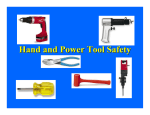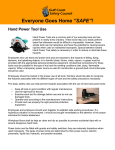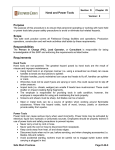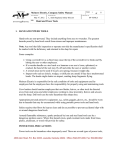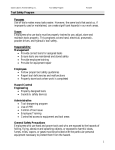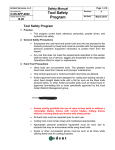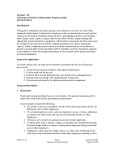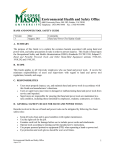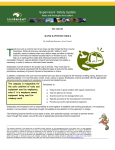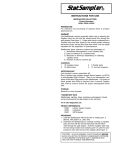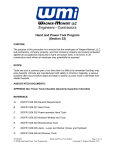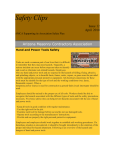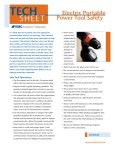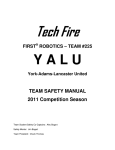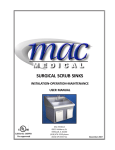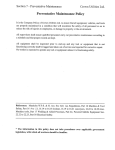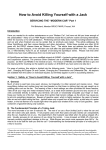Download Tools are such a common part of our lives that it is difficult to
Transcript
Villanova University Department of Environmental Health and Safety Policy and Procedure Manual Subject: Hand and Power Tool Policy Number: S24 Effective: 1 Nov 01 Revised: Feb 16, 2015 Tools are such a common part of our lives that it is difficult to remember that they may pose hazards. Tragically, a serious incident can occur before steps are taken to identify and avoid or eliminate tool-related hazards. All electrical connections for these tools must be suitable for the type of tool and the working conditions (wet, dusty, flammable vapors). When a temporary power source is used for construction a ground-fault circuit interrupter should be used. Workers should be able to recognize the hazards associated with the different types of tools and the safety precautions necessary. Six basic safety rules can help prevent hazards associated with the use of hand and power tools: 1. 2. 3. 4. 5. 6. Keep all tools in good condition with regular maintenance. Use the right tool for the job. Examine each tool for damage before use and do not use damaged tools. Operate tools according to the manufacturers’ instructions. Provide and use properly the right personal protective equipment. Use common sense. If a hazardous situation is encountered, it should be brought immediately to the attention of your supervisor for hazard abatement. Hand tools are tools that are powered manually. Hand tools include anything from axes to wrenches. The greatest hazards posed by hand tools result from misuse and improper maintenance. Employees, when using saw blades, knives, or other tools, should direct the tools away from aisle areas and away from other employees working in close proximity. Knives and scissors must be sharp; dull tools can cause more hazards than sharp ones. Cracked saw blades must be removed from service. Subject: Hand and Power Tool Policy Number: S24 Page 2 of 5 Wrenches must not be used when jaws are sprung to the point that slippage occurs. Impact tools such as drift pins, wedges, and chisels must be kept free of mushroomed heads. The wooden handles of tools must not be splintered. Appropriate personnel protective equipment such as safety goggles and gloves must be worn to protect against hazards that may be encountered while using hand tools. Workplace floors shall be kept as clean and dry as possible to prevent accidental slips with or around dangerous hand tools. Power tools must be fitted with guards and safety switches; they are extremely hazardous when used improperly. The types of power tools are determined by their power source: electric, pneumatic, liquid fuel, hydraulic, and power-actuated. • • • • • • • • • • • • Never carry a tool by the cord or hose. Never yank the cord of the hose to disconnect it from the receptacle. Keep cords and hoses away from heat, oil, and sharp edges. Disconnect tools when not using them, before servicing and cleaning them, and when changing accessories such as blades, bits, and cutters. Keep all people not involved with the work at a safe distance from the work area. Secure work with clamps or a vise, freeing both hands to operate the tool. Avoid accidental starting. Do not hold fingers on the switch button while carrying a plugged-in tool. Maintain tools with care; keep them sharp and clean for best performance. Follow instructions in the user’s manual for lubricating and changing accessories. Be sure to keep good footing and maintain good balance when operating power tools. Wear proper apparel and personal protective equipment (PPE) for the task. Loose clothing, ties, or jewelry can become caught in moving parts. Remove all damaged portable electrical tools from use and tag them: “Do Not Use.” Guards The exposed moving parts of power tools need to be safe-guarded. Belts, gears, shafts, pulleys, sprockets, spindles, drums, flywheels, chains, or other reciprocating, rotating, or moving parts of equipment must be guarded. Machine guards, as appropriate, must be provided to protect the operator and others from the following: Subject: Hand and Power Tool Policy • • • • Number: S24 Page 3 of 5 Point of operation. In-running nip points. Rotating parts. Flying chips and sparks. Safety guards must never be removed when a tools is being used. Portable circular saws having a blade greater than 2 inches (5.08 centimeters) in diameter must be equipped at all times with guards. An upper guard must cover the entire blade of the saw. A retractable lower guard must cover the teeth of the saw, except where it makes contact with the work material. Electric Tools Employees using electric tools must be aware of several dangers. Among the most serious hazards are electrical burns and shocks. Electrical shocks, which can lead to injuries such as heart failure and burns, are among the major hazards associated with electric-powered tools. Under certain conditions, even a small amount of electric current can result in fibrillation of the heart and death. To protect the user from shock and burns, electric tools must have a three-wire cord with a ground and be plugged into a grounded receptacle, be double insulated, or be powered by a low-voltage isolation transformer. Three-wire cords contain two current-carrying conductors and a grounding conductor. Any time an adapter is used to accommodate a two-hole receptacle, the adapter wire must be attached to a known ground. The third prong must never be removed from the plug. Double-insulated tools are available that provide protection against electrical shock without third-wire grounding. On double-insulated tools, an internal layer of protective insulation completely isolates the external housing of the tool. The following general practices should be followed when using electric tools: • Operate electric tools within their design limitations. • Use gloves and appropriate safety footwear when using electric tools. • Store electric tools in a dry place when not in use. • Do not use electric tools in damp or wet locations unless they are approved for that purpose. (Known GFIC) • Keep work areas well lighted when operating electric tools. • Ensure that cords from electric tools do not present a tripping hazard. Subject: Hand and Power Tool Policy Number: S24 Page 4 of 5 Pneumatic Tools Pneumatic tools are powered by compressed air and include chippers, drills, hammers, and sanders. There are several dangers associated with the use of pneumatic tools. First and foremost is the danger of getting hit by one of the tool’s attachments or by some kind of fastener the workers is using with the tool. Pneumatic tools must be checked to see that the tools are fastened securely to the air hose to prevent them from becoming disconnected. If an air hose is more than ½-inch (12.7 millimeters) in diameter, a safety excess flow valve must be installed at the source of the air supply to reduce pressure in case of hose failure. Pneumatic tools that shoot nails, rivets, staples, or similar fasteners and operate at pressures more than 100 pounds per square inch (6,890 kPa), must be equipped with a special device to keep fasteners from being ejected, unless the muzzle is pressed against the work surface. Eye protection is required, and head and face protection is recommended for employees working with pneumatic tools. Compressed air guns should never be pointed toward anyone. Workers should never “dead-end” them against themselves or anyone else. Noise is another hazard associated with pneumatic tools. Working with noisy tools such as jackhammers requires the proper, effective use of appropriate hearing protection. Liquid Fuel Tools Fuel-powered tools are usually operated with gasoline. The most serious hazard associated with the use of fuel-powered tools comes from fuel vapors that can burn or explode and also give off dangerous exhaust fumes. Handle, transport, and store gas or fuel only in approved flammable liquid containers. Before refilling a fuel-powered tool tank, shut down the engine and allow it to cool to prevent accidental ignition of hazardous vapors. Subject: Hand and Power Tool Policy Number: S24 Page 5 of 5 Powder-Actuated Tools Powder-actuated tools operate like a loaded gun and must be treated with extreme caution. In fact, they are so dangerous that they must be operated only by specially trained employees. When using powder-actuated tools, an employee must wear suitable ear, eye, and face protection. To prevent the tool from firing accidentally, two separate motions are required for firing. The first motion is to bring the tool into the firing position, and the second motion is to pull the trigger. The tool must not be able to operate until it is pressed against the work surface with a force of at least 5 pounds greater than the total weight of the tool. If a powder-actuated tool misfires, the user must hold the tool in the operating position for at least 30 seconds before trying to fire it again. If it still will not fire, the user must hold the tool in the operating position for another 30 seconds and then carefully remove the load in accordance with the manufacturer’s instructions. Hydraulic Power Tools The fluid used in hydraulic power tools must be an approved fire-resistant fluid and must retain its operating characteristics at the most extreme temperatures to which it will be exposed. All jacks—including lever and ratchet jacks, screw jacks, and hydraulic jacks—must have a stop indicator, and the stop limit must not be exceeded. Also, the manufacturer’s load limit must be permanently marked in a prominent place on the jack, and the load limit must not be exceeded.





